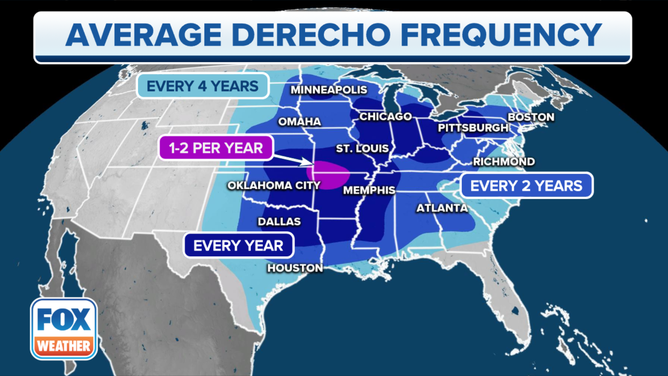Which are the most active months for damaging winds from severe storms, derechos?
June and July are the most active months for damaging thunderstorm winds in the U.S.
Which are the most active months for damaging winds from severe storms?
While thunderstorms can impact parts of the U.S. any time of the year, there is a distinct peak for damaging winds from severe storms in early summer.
While thunderstorms can impact parts of the U.S. any time of the year, there is a distinct peak for damaging winds from severe storms in early summer.
Long-term weather records show June and July are America's most active months for damaging thunderstorm winds, which sometimes include widespread, destructive damaging-wind events called derechos.
According to data from NOAA's Storm Prediction Center (SPC), an average of 3,187 reports of damaging winds are logged across the nation each June, followed by another 3,109 such reports each July.
The third- and fourth-most-active months are August and May, respectively, but with averages of around 2,000 or fewer damaging wind reports, neither of those months comes close to the more than 3,000 such reports seen in a typical June or July.
JUNE PACKED WITH SEASONAL WEATHER FIRSTS AS SUMMER BEGINS
Damaging thunderstorm wind reports include any recorded gusts of 58 mph or higher, as well as any reports of damage to structures, trees or power lines caused by a thunderstorm's strong winds.
June and July are the only months on record with more than 5,000 damaging wind reports. In June 2008, a total of 5,494 such reports were documented, the most of any month since at least 2000. July 2023 came close to that record, with 5,367 reports of damaging winds – that ranks in second place for the most such reports in a single month.
‘DESTRUCTIVE’ THUNDERSTORM ALERTS: WHAT THEY ARE AND WHY THE NATIONAL WEATHER SERVICE ISSUES THEM
Why are June and July the most active months?
In early summer, widespread warm and humid air is typically found in many areas east of the Rockies. The warmth and humidity provide some of the instability needed for thunderstorms to develop.
Additionally, the jet stream is typically parked near the U.S.-Canada border in June and July, and upper-level disturbances often get steered by the jet stream over the top of the warm, humid air engulfing parts of the central and eastern U.S. These disturbances can act as a trigger for the formation of thunderstorms.
The three-month period from May through July is also the most favorable time of year for derechos to develop. These clusters of thunderstorms produce destructive wind gusts for hundreds of miles and can impact millions of people along their path.
Derechos can form every year, but they don't happen very frequently.
One to two derechos per year are considered average for the region spanning southwestern Missouri, northwestern Arkansas and northeastern Oklahoma. A larger area from the southern Plains to the lower and mid-Mississippi Valley, the southern Great Lakes and the Ohio Valley typically sees about one per year.
The rest of the Plains, Midwest, South and East might only see a derecho once every two to four years.

The average derecho frequency across the United States. (Data: NOAA/NWS/SPC)
(FOX Weather)
For meteorologists to classify a windstorm as a derecho – from the Spanish word meaning "straight" – the swath of straight-line wind damage it causes must cover a distance of at least 400 miles and include wind gusts of more than 58 mph along most of its path, as well as several, well-separated 75-mph or higher gusts, according to the SPC.
One of the most significant derecho events in U.S. history occurred throughout much of the Midwest during the summer of 2020. During the event, winds gusted upwards of 140 mph, causing more than $7.5 billion in damage.
About 63% of all derechos occur between May and July, essentially coinciding with the most active months for damaging thunderstorm winds (June and July).
THIS IS AMERICA'S MOST ACTIVE TIME OF YEAR FOR TORNADOES

The percentage of derechos that occur in each month. (Data: NOAA/NWS/SPC)
(FOX Weather)
You should always take severe storms seriously, not just in the summer, but at any time of the year.
According to NOAA, severe thunderstorm winds killed 25 people across 15 states in 2021, with an additional 13 deaths reported in the Gulf of Mexico, one in Lake Michigan and another in the Atlantic – for a total of 40 deaths that year. Thirty-six people across 17 states were killed by severe thunderstorm winds in 2020.
More people died from severe thunderstorm winds than tornadoes in both 2018 and 2016.
In 2018, 24 people were killed by severe thunderstorm winds, but only 10 were killed by tornadoes. In 2016, there were 20 severe thunderstorm wind-related deaths but only 18 tornado-related deaths.
Be sure to download the FOX Weather app to track any storms in your area and receive potentially life-saving weather alerts issued by the National Weather Service. The free FOX Weather livestream is also available 24/7 on the website and app and on your favorite streaming platform. The FOX Weather Update podcast also provides weather information for the entire country.
